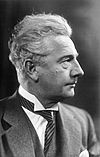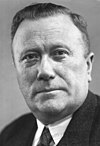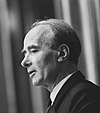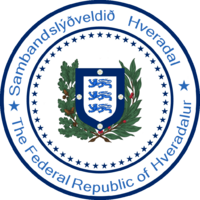President of the Federal Republic of Hveradalur: Difference between revisions
No edit summary |
No edit summary |
||
| Line 14: | Line 14: | ||
|incumbent = Askja Eskelson | |incumbent = Askja Eskelson | ||
|incumbentsince = 25 December 2014 | |incumbentsince = 25 December 2014 | ||
|style = ''Your Excellency'' | |style = ''Your Excellency'' ''Madam President'' | ||
|member_of = | |member_of = | ||
|residence = Presidential Palace, Raiko, Federal Republic of Hveradalur | |residence = Presidential Palace, Raiko, Federal Republic of Hveradalur | ||
Latest revision as of 14:44, 28 September 2022
| Federal President of the Federal Republic of Hveradalur | |
|---|---|
 Seal of the Federal President | |
 Standard of the Federal President | |
| Style | Your Excellency Madam President |
| Residence | Presidential Palace, Raiko, Federal Republic of Hveradalur |
| Appointer | People of the Federal Republic of Hveradalur |
| Term length | 8 Years, Renewable three times |
| Constituting instrument | Constitution of the Federal Republic of Hveradalur |
| Precursor | King of the Kingdom of Hveradalur |
| Formation | December 1910 |
| First holder | Kristian Haversson |
The Office of the Federal President of the Federal Republic of Hveradalur is the highest Executive Office of Hveradalur and is the Head of State of the Republic.
Under the 1910 Constitution Hveradalur has a Parliamentary System of Government in which the Federal Chancellor is the Head of Government. The Federal President has far-reaching Ceremonial Obligations, but also has the right and duty to act Politically. The Federal President can give direction to the general political and societal debates and have some important reserve powers in case of political instability. The Federal President also holds the prerogative to grant pardons on behalf of the Republic. The Federal President, who can be elected to three consecutive eight-year terms, have wide discretion about how they exercise their official duties.
According to the Federal Constitution, the Federal President represents the Federal Republic of Hveradalur in matters of International Law, concludes treaties with foreign states on its behalf and accredits diplomats. Furthermore, all Federal Laws must be signed by the Federal President before they can come into effect; a Federal President may veto any law if they believe it to violate the Federal Constitution.
The federal president's actions and public appearances represent the state itself, its existence, legitimacy, and unity. The federal president enjoys a higher ranking at official functions than the chancellor. The federal president's role is integrative and includes the control function of upholding the law and the constitution. It is a matter of political tradition – not legal restrictions – that the federal president generally does not comment routinely on issues in the news, particularly when there is some controversy among the political parties. This distance from day-to-day politics and daily governmental issues allows the president to be a source of clarification, to influence public debate, voice criticism, offer suggestions and make proposals. In order to exercise this power, they traditionally act above party politics.
The current office holder is Askja Eskelson, after being elected on 25 December 2014, this is her first term and the next Presidential Election is expected to be held on 25 November 2022 exactly a month before the next President is to take the Oath of Office.
Election
The Federal President is elected for a term of eight years renewable three time by a secret ballot. The Federal Presidential Canidates hold three Official Campaign Speeches that the Government is responsible for hosting. Upon the Election Date which is always a month before the Oath of Office date, 25 December, the election process used to Elected the Federal President is the Gustov Method which has been used since its inception in 1950.
The Federal President may run under a Political Party but is not required to do so by any Federal Law and may be elected as an Independent, out of the fourteen Presidential Elections three Federal Presidents have been elected as Independents.
Qualifications
The office of Federal President is open to all Hveradalur who are entitled to vote in Federal Presidential Elections and have reached the age of 30, but no one may serve more than three consecutive eight-year terms. As yet 2014, only three presidents (INSERT NAMES HERE) have been elected for a second or third term. The federal president must not be a member of the federal government or of a legislature at either the federal or state level.
Oath
After taking office the federal president must take the following oath, stipulated by constitution, in a session of the Alþingi. The religious references may optionally be omitted.
I swear that I will dedicate my efforts to the well-being of the Hveradalur people, enhance their benefits, avert harm from them, uphold and defend the Constitution and the statutes of the Republic, fulfil my duties conscientiously, and do justice to all. (So help me God.)
The Constitution does not consider oaths of office as constitutive but only as affirmative. This means that the president does not have to take the oath in order to enter office and use its constitutional powers. In practice, the oath is usually administered during the first weeks of a president's term on a date convenient for the Alþingi. If a president is re-elected for a second consecutive term, they do not take the oath again.
Duties and Functions
The president is involved in the formation of the Federal Government and remains in close cooperation with it. Basically, the president is free to act on his own discretion. However, according to the Constitution, the decrees, and directives of the president require the countersignature of the chancellor or the corresponding federal minister in charge of the respective field of politics. There is no need for a countersignature if the president proposes, appoints or dismisses the chancellor, convenes or dissolves the Alþingi according to the Constitution, declares a legislative state of emergency, calls on a chancellor and ministers to remain in office after the end of a chancellor's term until a successor is elected or exercises his right to pardon on behalf of the federation, as these are exclusive powers of the president.
Therefore, the president also receives the chancellor regularly for talks on current policy issues. The Federal Presidents also hold talks with individual federal ministers and other senior officials at their own discretion. The "Head of the Office of the President" represents the will and views of the president in the meetings of the Federal Cabinet and reports back to the president.
The Federal Presidents most Prominet Powers and Duties include:
- Proposing the federal chancellor to the Alþingi.
- Appointing and dismissing the federal chancellor and their cabinet ministers
- Dissolving the Alþingi under certain circumstances
- Declaring the legislative state of emergency under certain circumstances
- Convening the Alþingi
- Signing and promulgating laws or vetoing them under certain circumstances
- Appointing and dismissing federal judges, federal civil servants, and commissioned and non-commissioned officers of the Armed Forces
- Exercising the power to pardon individual offenders on behalf of the Republic
- Awarding honors on behalf of the Republic
- Representing Hveradalur at home and abroad
Appointment of the Federal Government
After the Constitution of the new elected Alþingi, which automatically ends the term of the Federal Chancellor, and in every other case in which the Office of Federal Chancellor has fallen vacant (death or resignation), the President will propose an individual as Federal Chancellor and must then, provided the individual is subsequently elected by a majority of the members of the Alþingi on the first ballot, appoint the elected candidate to office. The Alþingi is also free to disregard the Federal Presidents proposal, in which the Alþingi must within fourteen days elect another individual, whom the parties in the Alþingi now choose themselves, to post the same, who the Federal President is obligated to appoint to office. If the Alþingi does not manage to do so, on the fifteenth day after the first balled the Alþingi must hold one last ballot: if an individual is elected by the Alþingi, the Federal President is also obliged to appoint the elected candidate. If no clear consensus was reached, then the Federal President can either appoint as Federal Chancellor the individual who received a plurality of votes on this last ballot or dissolve the Alþingi. The Federal President can dismiss the Federal Chancellor, but only if and when the Alþingi passes a constructive vote of no confidence, electing a new Federal Chancellor following the same procedures as for any appointment of a Federal Chancellor.
The Federal President also appoints and dismisses the remaining members of the Federal Government upon the proposal of the Federal Chancellor. This means that the Federal President can appoint only those candidates presented by the Federal Chancellor. The Federal President can also refuse to dismiss or appoint a Federal Minister proposed by the Federal Chancellor if they feel this person should not be in that Office.
The Federal President also appoints the Federal Justices and Judges of the Federal Judiciary, Federal Civil Servants, and Military Officers of the Armed Forces of the Republic.
Dissolution of the Alþingi
In the event the Alþingi elects an individual for the office of federal chancellor by a plurality of votes, rather than that of a majority, on the fifteenth day of the election process, the Federal President can, at his/her discretion, either appoint that individual or dissolve the Alþingi, triggering a new election. If a vote of no confidence is defeated in the Alþingi, and the incumbent federal chancellor proposes a dissolution, then the federal president may, at his/her discretion, dissolve the Alþingi within twenty-one days. This power of the federal president has only been used once in 1966 and was seen as constitutional.
Promulgation of the law
All federal laws must be signed by the federal president before they can come into effect. The federal president may refuse to sign any law, thus effectively vetoing the law. In principle, the federal president has the full veto authority on any bill, but this has never been used in that effect. Typically, the federal president checks if the law was passed according to the order mandated by the constitution and/or if the content of the law is constitutional. Only in cases in which the federal president had serious doubts about the constitutionality of a bill laid before them, he/she may refuse to sign it. It also has to be stated that the federal president may at his/her own discretion sign such a "vetoed" bill at any later time, if for example the constitution has been changed in the relevant aspect or if the bill in question has been amended according to his/her concerns, because his/her initial refusal to sign a bill is not technically a final veto.
Foreign Relations
The Federal President represents Hveradalur in the International Realm, undertakes Foreign Visits, and receives Foreign Dignitaries. They also conclude treaties with foreign nations, accredit Hveradalur Diplomats and receive the letters of accreditation of Foreign Diplomats.
Pardons and Honours
According to the Federal Constitution of the Republic, the federal president has the power to pardon. This means that the federal president "has the authority to revoke or commute penal or disciplinary sentences in individual cases. The federal president cannot, however, issue an amnesty waving or commuting sentences for a whole category of offenses. That requires a law enacted by the Alþingi. Due to the federal structure of Hveradalur the federal president is only responsible for dealing with a handful of criminal matters and disciplinary proceedings against federal civil servants, federal justices and judges, and soldiers.
The Federal President awards all Federal Honours of the Federal Republic of Hveradalur to any Citizen of the Republic or Foreign Recipient of the award, this includes any Federal or state Honours that have been established within the Realm of Hveradalur.
Legislative State of Emergency
Under the Federal Constitution it is possible to enact a law without the approval of the Alþingi: if the Alþingi rejects a motion of confidence, but a new federal chancellor is not elected nor is the Alþingi dissolved, the chancellor can declare a draft law to be "urgent". If the Alþingi refuses to approve the draft, the cabinet can ask the federal president to declare a "legislative state of emergency" with regard to that specific law proposal.
Once the federal president declares the legislative state of emergency, the Alþingi has five weeks to discuss the draft law. If it does not approve it then the cabinet can ask the federal president and the constitutional court to approve the draft. After the consent of the federal president and the constitutional court, the draft automatically becomes a law.
There are a few constraints on the "legislative state of emergency". After the federal president has declared the state of emergency for the first time, the government has only five months to use the procedure for other law proposals. Given the terms provided by the constitution, it is unlikely that the government can enact more than one other draft law in this way.
Also, the emergency has to be declared afresh for every proposal. This means that the five months are not a period which the government together with the federal president and the constitutional court replaces the Alþingi as lawgiver. The Alþingi remains fully competent to pass laws during these six months. The state of emergency also ends if the office of the federal chancellor ends. During the same term and after the five months, the federal chancellor cannot use this procedure again for their term.
Politics and Influences
Thought candidates are usually selected by a political party or parties, the federal president is traditionally expected to refrain from being an active member of any part after assuming office. Every federal president to date, except three, have suspended their party memberships for the duration of their term. Federal Presidents have, however, spoken publicly about their personal views on political matters. The very fact that a federal president is expected to remain above politics usually means that when they do speak out on an issue, it is considered to be of great importance, this tradition started under the Ahranaian Monarchy and was borrowed when the Republic was established.
Reserve Powers
In accordance with the Constitution of the Republic, the federal president can declare a "legislative emergency" and allow the federal government to enact laws without the approval of the Alþingi. The federal president also has the important decisive power regarding the appointment of a federal chancellor who was elected by plurality only, or the dissolution of the Alþingi under some circumstances.
Succession
The Constitution of the Republic did not create an Office of Vice President but did designate the President of the Alþingi as deputy of the federal president of the republic. If the Office of Federal President falls vacant, the President of the Alþingi temporarily assumes the powers of the Federal President and acts as the head of state until a successor is elected but does not assume the office of federal president as such. While carrying out the duty at temporary federal president the president of the Alþingi may not perform their duties, they can at their own discretion delegate their powers or parts of them to the Vice-President of the Alþingi.
If the federal president dies, resigns, or is otherwise removed from office, a successor is to be elected no later than thirty days to that date.
Impeachment and Removal
While in Office, the Federal President enjoys immunity from prosecution and cannot be voted out of office or recalled. The only mechanism for removing the Federal President is impeachment by the Alþingi and trialed by the Supreme Court. Once the Alþingi has impeaches the federal president then the Supreme Court is charged with determining if they are guilt of the offence. If the charge is sustained, the court has the authority to remove the federal president from office.
Presidential Office and Symbols
Residences
The official residence of the Federal President is the Presidential Palace in the capital. The Presidential Palace is the former Royal Palace of the Hveradalur Prince that lead the country before Independence. The President does have a second official residence in the lower part of the country called the Summer Palace.
Although these are the Federal Presidents Official residences, the president may live in another residence if they desire to do so.
The Office of Federal President is a Supreme Federal Authority. It organizes the federal president's work, supports the federal president in the performance of their duties as head of state and coordinates their working relationships with other parts of the republic. The top official, who takes precedence over all Regional Secretaries, is the Chief of Staff of the Federal President.
The office and its staff advise the federal president informs them of all developments in domestic and foreign affairs and carries out the instructions of the federal president or forwards these to the corresponding ministry or authority.
All Symbols of the Federal President are considered National Symbols and are to be treated as such as stated by the Federal Constitution of 1910 of the Republic. Any violations to the symbols of the federal president can be punished by the court of law as a hate crime.
Transportation
The federal president uses a variety of cars and other vehicles that are used to transport the federal president from place to place. The most common and used vehicles are always either black or silver, have a diplomatic plate with designated numbers of 0000 or triple zeros as it is called, and fly's the presidential standard on the left and right front part of the car.
The federal president also has a modified version of the MH-32A Helicopter produced by the Malte & Gjord Aircraft Company. The modified version of the MH-32A has a white Stripe painted on the top half of the aircraft with the bottom half being the blue from the national flag of Hveradalur.
Presidential Standard
The Federal President has a Standard that is flown on the flag poles on either of the palaces they are in at the time, or any other building (if they have a flagpole) that the federal president takes up office in for that period of time. The Standard is a flag of the proportion of 3:5 with the Seal of the Office of President in the Center with the outline being gold and the center portion being light blue from the national flag.













